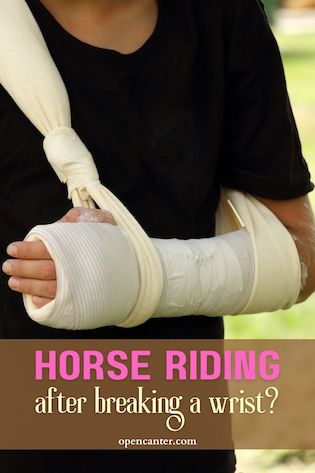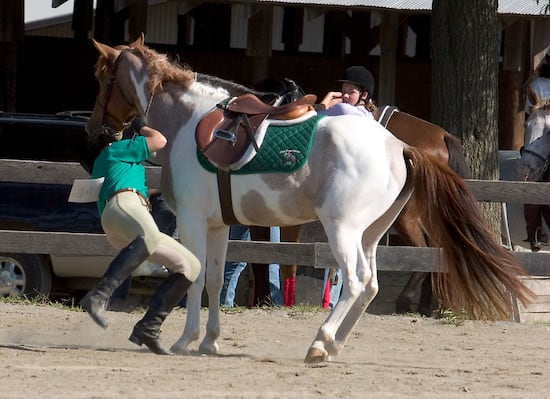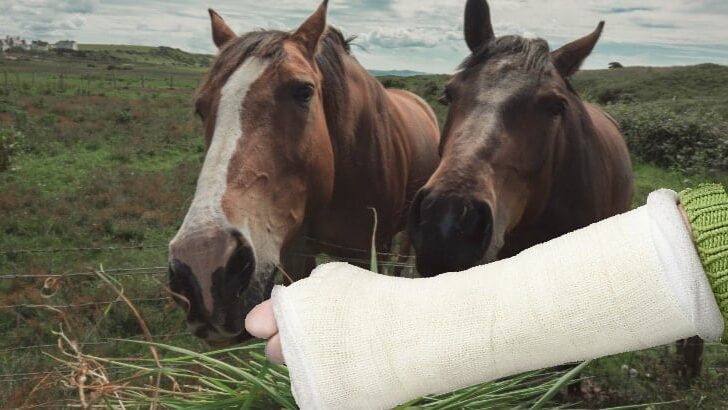Affiliate Disclaimer
As an Amazon Associate I earn from qualifying purchases. It helps me keep the website going. Thank you for your support.
When I broke my wrist the first question in my mind was how long it would be before I could horse ride again. If you are a horse nut, and you have had a fracture, you are probably stressing about that too. So, I thought it would be helpful to share my experience of what you can expect when horse riding after a broken wrist. This is what I have learned…
Wrist fractures are often described as ‘unstable’, meaning that the bones can move easily before they have healed properly. For that reason, activities like horse riding which involve pushing, pulling, and sometimes jolting are best avoided until you have had clearance from the doctor.
Disclaimer: I should say that I’m not a doctor, so I can’t offer any medical advice. This is my shared experience. I’d always recommend consulting an appropriate medical professional when it comes to matters of health.

When Can You Start Horse Riding After a Broken Wrist?
When you have a fracture this is the question that seems to be most pressing for most riders. And the answer that you get will depend upon whom you ask. So let’s look first at what the doctors say…
What The Doctors Say
Initially, when I arrived at the hospital, I was x-rayed and advised that my wrist was broken in four places. The emergency medics did a very good job of realigning the bones.
Then the wrist was put in a cast from my knuckles to my elbow, and I was given a sling. The doctor and nurse told me to rest my arm and keep it elevated. At that point, my wrist felt so vulnerable not to mention painful that the idea of getting on a horse was the last thing I wanted to do.
However, when I went back a week later for a follow-up x-ray I did speak to the doctor about how long it would be before I could start riding again. The doctor rolled his eyes in a good-natured way. He said that over the years he had treated the fractured bones of many equestrians.
As a result, he was not surprised by my eagerness to know how long I would be out of the saddle. Nevertheless, he did not mince his words. He strongly advised me not to ride until my wrist was properly healed.
This didn’t just mean waiting until the cast was off in six weeks’ time. He also expected that there would be a substantial period after that when I would need physiotherapy. And this is why…
The Risks of Riding too Soon After a Wrist Fracture
These are some of the risks of horse riding too soon after a broken wrist:
- Wrist fractures are notoriously unstable. This means that during the early stages of the healing process bones that have been carefully realigned by the medics, can easily become displaced.
- Sometimes after a wrist fracture surgery is required to reposition the bones and hold them in place as they heal. This isn’t always the case, and surgery isn’t always required. But regardless of whether you had to have surgery or not, horse riding after a broken wrist can pull the bones out of alignment again.
If the bones become displaced in the early stages of healing, chances are surgery will be necessary to undo the complications caused by riding again too soon. - In turn, this can extend the healing process considerably. Bones normally heal in 6 to 8 weeks. And it’s not uncommon for physiotherapy to be necessary after the cast has come off a broken wrist. For me, it took two months of focused physiotherapy to get my wrist to a place where I felt confident to ride.

via Wikimedia Commons
Had I taken the chance, and gone horse riding too soon after a broken wrist, there is a possibility that my recovery time would’ve taken much longer.
3 and ½ months already felt like a long enough period of time to be out of the saddle. And I didn’t want to take the risk of making the process any longer than it absolutely needed to be.
What Other Riders Will Tell You
Having said that, I spoke to a number of fellow horse riders to find out what their experience had been of horse riding after a fracture. What I found is that people’s approach to recovering after breaking bones is very different.
Some riders are confident that it’s okay to ride, even whilst wearing a cast. In fact, I found that other people’s experience of recovering from a wrist fracture was sometimes very different from mine.
I had quite a bit of pain and discomfort in my arm and it wouldn’t have felt bearable to ride any earlier than I did.
But some riders seemed to feel able to ride throughout most of the six weeks when the cast was on. Ted Edgar, the showjumping legend, rode the Hickstead Derby in 1963 with a broken arm in a sling (source).
I also did some reading around on a number of horse riding forums and got some feedback from other riders who had had the same experience. It does seem that there is a very mixed set of opinions about what it is safe to do when you have your arm in a cast.
However, my inclination is to trust medics on this matter, and I decided to stick doggedly to their guidelines.
Horse Riding After a Broken Wrist – What Can Go Wrong?
It’s tempting to think, that whilst you’re recovering it will be okay to have a gentle walk around the paddock or an ambling trail ride. However, there are lots of things that can put a strain on a wrist that is recovering. Including the following:
Spooking: even if you ride a very solid horse, who tends not to spook, horses can be unpredictable, and there is no guarantee that any horse is going to stay calm when you really need them to. You can read more about spooking here.
Rooting at the bit: some horses fall into the habit of tossing their heads or quickly dropping their head in order to loosen the reins in your hand. This is known as rooting. If your wrist is still vulnerable after a fracture, a sudden yank on the reins could cause you further damage. You can read more about how to stop your horse rooting at the bit here.
Learning bad habits: if you are relying on your good hand to communicate with the horse, you and your horse may fall into relying on incorrect technique. This may involve some unlearning once you are fully recovered.
Taking advantage: Some horses are very smart and can tell straight away if you are not able to use your hands as you normally would. Certain horses will take advantage of this and use it as an opportunity to act up whilst you don’t have your normal level of physical strength and agility.

Other Things You Shouldn’t Overlook
In addition to the concerns outlined above, there are a few other things to bear in mind when you are horse riding after a broken wrist…
1) Riding fitness levels
Like any kind of sporting activity, if you take a break, your fitness level will decline. I was shocked to find out how breathless I was after a short canter once I did finally start riding again. Being out of the saddle for just over three months really had an impact on my riding fitness.
Nevertheless, fitness levels do seem to recover fairly quickly. However, I did find it took a bit longer to regain my physical strength…
2) Muscle strength
Whilst your arm is in a cast, or a splint, or being supported by a sling, you will be losing muscle strength. When you start being able to ride again, it’s likely that you were going to be pretty out of shape.
A combination of physiotherapy and a sensible exercise regime will help you to regain the muscle that you have lost. I found regaining the muscle took longer than regaining my general fitness level.
3) Stiffening up
The whole point of a cast and a sling is to protect and immobilize your limbs and joints. One of the things that happens when your arm is immobilized is that the joints become stiff. It’s not uncommon for hands and shoulders to be very stiff once the cast is removed.
This can make using the reins effectively a real challenge at least to start off with. Everyone’s body is different, but it’s not unusual for it to take several months to regain the kind of flexibility or mobility that you had before the accident.
4) Insurance issues
It’s worth bearing in mind that having an injury may affect your insurance. If you have horse riders insurance, also called equine insurance, it would be wise to check with your insurer what their policies are around recovering from injury.
5) Post-traumatic arthritis
This is an inflammation of your joints after you have experienced physical trauma, like a fracture. It’s often temporary, but it’s more likely to happen if you re-injure the same joint.
So, making sure that you have a good recovery period before horse riding after a broken wrist seems like a very good idea.
Things to do Instead of Riding Whilst Your Wrist Heals
It can be disappointing having to sit on the sidelines after a wrist injury. However, being forced to slow down it’s not always a bad thing.
There are other things that you can do, whilst you’re recovering. You may even find in the long run these alternative ways of engaging with horses will actually benefit your riding skills. Here are some suggestions about how you can use your recovery time fruitfully:
- Groundwork: focusing with your horse on some groundwork is a good way to develop communication between you and your horse. It is also an excellent way of exercising your horse, without you needing to be in the saddle.
- Observe others riding: admittedly it’s not quite so much fun watching other people ride as it is to be the one doing the riding. However, you can learn a lot from watching other people being trained or exercising their horses.
Even better, if you own your own house, it can be very helpful to watch somebody else riding a horse you’re very familiar with. Other people, especially experienced riders will have a different way of riding and interacting with your horse. And this can be very helpful to observe.
Final Thoughts
Allowing time to heal and waiting to go horse riding again after you have broken a wrist can feel painfully slow. By the end of the six-week period, I was desperate for the cast to be removed. But ultimately I’m glad that I waited as long as I did. My thinking was it in the general scheme of things, waiting until I’ve had enough physio at my hand and wrist felt strong again was the right thing to do for me.




